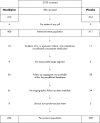Long term effects of nisoldipine on the progression of coronary atherosclerosis and the occurrence of clinical events: the NICOLE study
- PMID: 12860866
- PMCID: PMC1767780
- DOI: 10.1136/heart.89.8.887
Long term effects of nisoldipine on the progression of coronary atherosclerosis and the occurrence of clinical events: the NICOLE study
Abstract
Background: Earlier angiographic studies have suggested that calcium antagonists may prevent the formation of new coronary lesions and the progression of minimal lesions. Conversely, a meta-analysis suggested that these drugs may increase cardiovascular mortality and morbidity in patients with coronary heart disease.
Objective: To investigate whether nisoldipine retards the progression of coronary atherosclerosis or reduces the occurrence of clinical events.
Design and setting: The NICOLE study (NIsoldipine in COronary artery disease in LEuven) is a single centre, randomised, double blind, placebo controlled trial with coronary angiography at baseline, six months, and three years of follow up.
Patients: 826 patients who had undergone successful coronary angioplasty were randomised to nisoldipine 40 mg once daily or placebo. The intention to treat and per protocol population consisted of 819 and 578 patients, respectively.
Results: In the per protocol population, 625 of the nisoldipine treated and 655 of the placebo treated patients (NS) showed angiographic progression in at least one coronary arterial segment, defined as an increase in diameter stenosis of > or = 13%. The average minimum luminal diameter of the non-dilated lesions decreased by 0.163 mm and 0.167 mm in the nisoldipine and placebo groups, respectively (NS). The respective numbers of new lesions detected were 7 and 13 (NS). In the intention to treat population, the rates of death, stroke, and acute myocardial infarction were similar in both treatment groups. However, nisoldipine use was associated with fewer revascularisation procedures and thus the percentage of patients with any clinical event was lower (44.6% v 52.6%, p = 0.02).
Conclusions: Nisoldipine has no demonstrable effect on the angiographic progression of coronary atherosclerosis or the risk of major cardiovascular events but its use is associated with fewer revascularisation procedures.
Figures
References
-
- Lüscher T, Wenzel R, Moreau P, et al. Vascular protective effects of ACE inhibitors and calcium antagonists: theoretical basis for a combination therapy in hypertension and other cardiovascular diseases. Cardiovasc Drugs Ther 1995;9:509–23. - PubMed
-
- Willis AL, Nagel B, Churchill V, et al. Antiatherosclerotic effects of nicardipine and nifedipine in cholesterol-fed rabbits. Atherosclerosis 1985;5:250–5. - PubMed
-
- Lichtlen P, Hugenholtz P, Rafflenbeul W, et al, on behalf of the INTACT Group Investigators. Retardation of angiographic progression of coronary artery disease by nifedipine. Results of the international nifedipine trial on antiatherosclerotic therapy (INTACT). Lancet 1990;335:109–13. - PubMed
-
- Waters D, Lespérance J, Francetich M, et al. A controlled clinical trial to assess the effect of a calcium channel blocker on the progression of coronary arteriosclerosis. Circulation 1990;82:940–53. - PubMed
Publication types
MeSH terms
Substances
LinkOut - more resources
Full Text Sources
Medical
Miscellaneous

